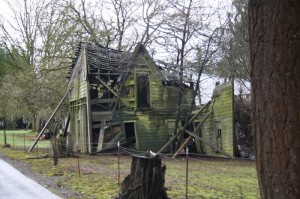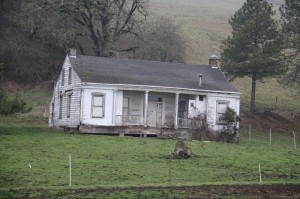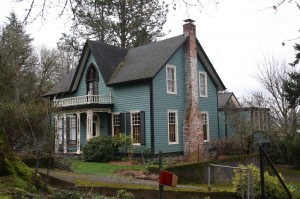
homesteads are in rapidly declining condition.
This January 2013 photograph shows an un-designated
circa 1850 house located in Canby.
(photo courtesy of Kenneth Gunn)
Since the 1960s, Oregon’s state and local governments have conducted architectural field surveys of groupings of older buildings, each with varying levels of significance and importance, in order to document and understand Oregon’s historic places. One that was completed over the last year holds special significance to the history, people, and development of Oregon as a whole: settlement-era homesteads in the Willamette Valley.
The goal of this survey was to gain a better understanding of the first homesteads that were constructed by the original pioneers to Oregon, including both those that are still standing and those that have been demolished since these buildings were originally surveyed by preservationists as far back as 40 years ago. The boundaries of the survey were narrowed to the Willamette Valley’s nine counties: Benton, Clackamas, Lane, Linn, Marion, Multnomah, Polk, Washington, and Yamhill. Architectural resources that were included in the survey were constructed between 1840 and 1865, however, the styles and features of each individual resource varies greatly due to the pioneers’ diverse personal interests and understandings of what a house should look like. The survey also included relevant outbuildings that were essential parts of a homestead during this era, including barns, outhouses, chicken coops, and other miscellaneous functional structures.

in Polk County, was surveyed as part of the Historic
American Building Survey in 1934 and was listed in
the National Register of Historic Places in 1975.
Today the house sits underutilized and in critical need
of rehabilitation and reuse.
(photo by Kenneth Gunn, December 2013)
As one could imagine, most of these buildings are not located in downtowns along paved roads with well-marked addresses or street signs. This particular survey involved driving down countless dirt and gravel roads that were unmarked on the hunch that there may be a settlement-era house down the “road.” Once I discovered or rediscovered a settlement-era homestead, I updated location information to include accurate GPS coordinates and addresses based on current road names.
I would, of course, like to say that I did not trespass on any private property during the duration of my time in the field doing survey for this project. However, as any architectural historian or historic preservationist who has worked on a project similar to this knows, harmless trespassing can be worth the risk—assuming you get a photograph of that one building that the public hasn’t seen in over a hundred years and may never see again. Most of these houses are located in such rural areas that it prevents the typical Oregonian from ever getting the privilege of witnessing the pure elegance and craftsmanship that buildings from the 1840-1865 time period still portray today. As I conducted the survey, it became a personal goal of mine to see all of these resources first-hand in order to educate and show Oregonians the beauty and presence of these irreplaceable resources that are at great risk of demolition, collapse, alteration, and neglect.
The survey included visiting about 300 properties within all counties of the Willamette Valley. A total of 57 previously recorded properties have since been demolished. This frightening statistic means that over the last 40 years—since historic places in Oregon first began to be documented and photographed—nearly 20% of the earliest buildings and homes constructed in the Willamette Valley have been demolished! And, more so, research conducted by Restore Oregon show that these losses bring us down to just 5% the homes and homesteads that were standing in 1865.

Street S. in Salem, demonstrates that rehabilitation of
settlement-era properties is viable in some parts of the
Willamette Valley.
(photo by Kenneth Gunn, March 2013)
Overall, it was truly a privilege to be asked to be a part of this project, as I got to see countless incredible resources that many architects, architectural historians, historic preservationists, and other professionals interested in the built history of Oregon may never get to see. I will never forget the images of many of these homesteads, as it is my ultimate dream that the data and photographs that I collected in 2013 will result in the protection and rehabilitation of one or possibly even several of these resources. This would allow future generations of Oregonians to truly learn and understand what it was like to live in this place at a time when Oregon first became known as Oregon.
The survey was funded by the State Historic Preservation Office in coordination with Restore Oregon’s 2013 Most Endangered Places program. To see information on each property identified in the survey, visit the Oregon Historic Sites Database and enter the Group Name “Settlement-Era Homesteads in the Willamette Valley.”


One Reply to “Rediscovering Settlement-Era Homesteads in the Willamette Valley”
Comments are closed.